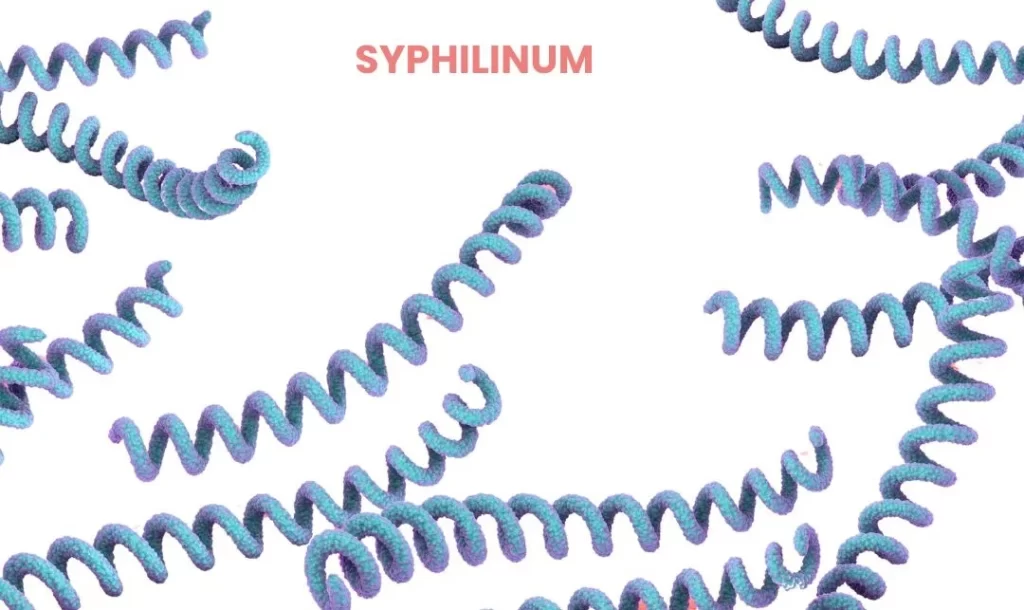Syphilinim is a homeopathic remedy derived from the syphilitic virus, used to address various symptoms related to syphilitic and chronic conditions.
It is often utilized in cases where there are severe, chronic symptoms with an underlying syphilitic etiology.

Table of Contents
ToggleSOURCE INFORMATION
Source Information
- Scientific Classification: A nosode made from the syphilitic virus.
- Origin: The remedy is prepared from the syphilitic virus, used in homeopathy to address symptoms arising from syphilis and related conditions.
- Historical Facts: Nosodes like Syphilinim are used in homeopathy based on the principle of using disease products to treat similar disease states.
- Syphilinim has a historical use in treating chronic and complex symptoms associated with syphilis.
DRUG PATHOGENESIS
Cerebro-Spinal System
- Causes significant prostration, mental confusion, and severe loss of control, including a sense of impending insanity.
- Produces linear headaches, delirium, and a sensation of the head being detached.
Circulatory System
- Induces shifting rheumatic pains and chronic eruptions.
- Results in severe debility, especially in the morning, and systemic weakness.
Dermatological Effects
- Leads to extensive ulceration of the skin and mucous membranes.
- Causes reddish-brown eruptions and ichthyosis (dry, scaly skin).
Gastrointestinal System
- Stimulates cravings for alcohol and can cause ulceration in the mouth.
Genito-Urinary System
- Results in profuse, acrid leucorrhea in females and ulcerations in genital regions.
Sensory Organs
- Produces intense photophobia, recurrent corneal inflammations, and caries of the ear ossicles and nasal bones.
KEY SYMPTOMS
GENERAL SYMPTOMS
- Utter prostration and debility, especially in the morning.
- Shifting rheumatic pains and chronic eruptions.
- Ulcerations in mouth, nose, genitals, and skin.
- Succession of abscesses and a tendency toward the development of ichthyosis.
MENTAL SYMPTOMS
- Loss of memory with a vivid recollection of events before the illness.
- Apathetic, feeling as if going insane or being paralyzed.
- Fear of the night and a sense of hopelessness or despair.
HEAD SYMPTOMS
- Linear headaches from the temples or eyes, leading to sleeplessness and delirium.
- Pain in the bones of the head and a sensation that the top of the head feels detached.
- Stupefying cephalalgia.
EYE SYMPTOMS
- Chronic, recurrent phlyctenular inflammation of the cornea.
- Intense photophobia, profuse lachrymation, and swollen eyelids.
- Diplopia (seeing one image below the other) and a sensation of cold air on the eyes.
EAR SYMPTOMS
- Caries of the ossicles, often of syphilitic origin.
NOSE SYMPTOMS
- Caries of the nasal bones, hard palate, and septum with perforation.
- Ozona (fetid nasal discharge).
MOUTH SYMPTOMS
- Decayed, serrated teeth with a coated, indented tongue.
- Deep longitudinal cracks, burning ulcers, and excessive salivation (drooling).
STOMACH SYMPTOMS
- Persistent craving for alcohol.
RECTAL SYMPTOMS
- Feelings of strictures, painful enemas, fissures, and prolapse.
EXTREMITIES SYMPTOMS
- Sciatica, worsening at night but improving around daybreak.
- Severe pain in long bones and indolent ulcers.
- Muscles contracted into hard knots and rawness between toes.
FEMALE SYMPTOMS
- Ulcers on labia and profuse, thin, acrid leucorrhea with sharp ovarian pain.
RESPIRATORY SYMPTOMS
- Aphonia (loss of voice), chronic asthma with wheezing, and sensitive windpipe.
- Dry, hard cough that worsens at night.
SKIN SYMPTOMS
- Reddish-brown eruptions with a disagreeable odour and extreme emaciation.
MODALITIES
- Worse: Symptoms worsen at night (from sundown to sunrise), at the seashore, and in summer.
- Better: Symptoms improve during the day, in inland and mountainous regions, and with slow movement.
WHAT ARE MODALITIES IN HOMOEOPATHY?
RELATIONSHIP WITH OTHER DRUGS
Compare:
- Merc: For similar syphilitic and inflammatory conditions.
- Kal Hyd: For skin and mucosal conditions.
- Nit Ac: For ulcerative and inflammatory conditions.
- Aur: For general systemic effects.
- Alum: For specific skin and muscular issues.
DOSE
- Homeopathic Use: Administer in the highest potencies with infrequent doses. The exact dosage should be tailored to individual symptoms and guided by a practitioner.
Frequently Asked Questions (FAQs)
What types of conditions is Syphilinim used for?
- It is used for chronic symptoms related to syphilis, including skin eruptions, mouth ulcers, and systemic debility.
How should Syphilinim be administered?
- It is typically administered in high potencies and infrequently.
- Consultation with a homeopathic practitioner is recommended for precise dosage.
What are the key modalities for Syphilinim?
- Symptoms tend to worsen at night, particularly from sundown to sunrise, and in summer, while improving during the day, in inland areas, and with gentle movement.
Can Syphilinim be used for acute conditions?
- It is generally used for chronic conditions and may not be the first choice for acute situations.
- Always consult a practitioner for appropriate treatment plans.
Glossary
- Nosode: A homeopathic remedy prepared from disease products.
- Phlyctenular Inflammation: A type of eye inflammation involving small, round, elevated lesions on the conjunctiva or cornea.
- Ozona: A foul-smelling nasal discharge often associated with advanced nasal infections.
- Diplopia: Double vision.
- Ptosis: Drooping of the upper eyelid.
- Sciatica: Pain along the sciatic nerve, typically radiating from the lower back down the leg.
- Emaciation: Extreme weight loss or wasting of body tissues.
